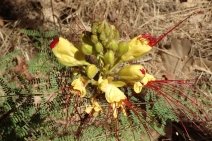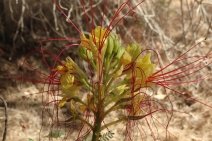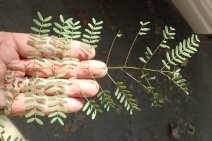Argentina and Uruguay
Evergreen (semi-deciduous to deciduous in the northern parts of its growing range) shrub or small tree in the pea family that typically grows to 10’ tall but occasionally rises to as much as 15’. It is native to subtropical areas of Argentina and Uruguay, but is now widely grown in tropical and warm temperate regions around the world for its attractive yellow flowers with bright red stamens which bloom in summer in upright open racemes on branches clad with fern-like bipinnate compound green leaves. It was introduced into the southwestern U.S. a number of years ago where it has now escaped gardens and naturalized from California and Nevada to Oklahoma and Texas plus Georgia. It is unrelated to Strelitzia reginae of South Africa which is a smaller clump-forming perennial that is also commonly known as bird-of-paradise. Each leaf (4-8” long) has 8-12 pairs of pinnae with each pinna having 7-11 pairs of elliptic leaflets (each to 1/2” long). Bruised foliage often has an unpleasant smell. Five-petaled, pale yellow flowers (to 4-5” long), each featuring 10 showy red stamens, bloom in open terminal racemes in summer (July-August). Flower is about 1” long, but the stamens protrude from the flower tube for another 3-4”. Fruits are curved, flattened, linear to sickle-shaped, 8-10 seeded pods (each to 2-5” long) which split open at maturity to explosively expel seeds in all directions, thus facilitating naturalization in the landscape.
It is native to subtropical areas of Argentina and Uruguay, but is now widely grown in tropical and warm temperate regions around the world for its attractive yellow flowers and fern-like compound green leaves. It was introduced into the southwestern U.S. a number of years ago where it has now escaped gardens and naturalized from California and Nevada to Oklahoma and Texas plus Georgia.


